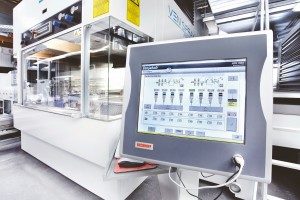 With the advancement and emergence of new technologies over the years, the Factory of the Future is beginning to take shape. And thanks to technologies such as Big Data, the Cloud, and Industry 4.0, machinery manufacturing is currently undergoing a significant transformation.
With the advancement and emergence of new technologies over the years, the Factory of the Future is beginning to take shape. And thanks to technologies such as Big Data, the Cloud, and Industry 4.0, machinery manufacturing is currently undergoing a significant transformation.
But what exactly does this Factory of the Future look like in regards to structure, technologies, and processes?
In a recent article, Boston Consulting Group addressed these questions through analyzing a recent global survey the consulting firm conducted of more than 750 manufacturing product leaders from leading companies in three industrial sectors: automotive, engineered products, and process industries. Overall, the purpose of the survey was to generate a blueprint for the Factory of the Future in 2030.
Integration and the Factory of the Future’s growth
The fundamental characteristic of the Factory of the Future is to achieve real-time integration based on intelligent objects that connect diverse enterprise systems. These will, in turn, demonstrate the future of Application Programmer Interfaces (API). These APIs are essential to enabling Factories of the Future because of their potential to improve and to be capable of providing insight and intelligence. Here are some of the ways integration is impacting the Factory of the Future:
1. Overall improvement and acceleration of value chains
- High levels of intelligence in each integration point across value chains
- Greater lean management benefits
- The collaboration of smart robots
2. Real-time integration as critical to the Factory of the Future’s realization
- Real-time integration allows for multidirectional layouts, modular line setups, sustainable production, organization or smart and collaborative robotics, and Big Data and analytics plans
3. Integration of large-scale enterprise systems
- Includes SAP, Salesforce, as well as 3rd party and homegrown systems
- A significant need for global manufacturers is improving the product, process, and service quality without raising costs
- Improving integration systems makes manufacturers more trusted in selling next-generation products
- Collecting data with real-time integration can find patterns which can then be used to increase product quality
4. Real-time integration in manufacturing systems creates multi-directional layouts of production workflows
- Information on how to best collaborate and deliver high-quality products
- Allows for assembly layout changes quickly and without having a negative impact on production
- Field mapping between different systems
5. Flexibility in terms of changing customer requirements
- Depends on real-time integration of production and customer-facing systems
- Critical for manufacturers to be able to create new business models centered on the improvement of lean manufacturing
Big Data and Big Data analytics
Big Data technologies have become increasingly important to companies and organizations around the world because of their potential to give a competitive edge to those companies and organizations that are able to use these tools and technologies in symbiosis with the customer experience and data science.
Many companies are striving to make the most of Big Data technologies and applications, including machine learning and data analytics, to deliver a more fine-tuned customer experience.
Big Data has been accurately described by MongoDB as “technologies and initiatives that involve data that is too diverse, fast-changing or massive for conventional technologies, skills, and infrastructure to address efficiently.” Big Data is leading the way when it comes to enabling companies and enterprises to gain unprecedented business value.
Some of the most useful Big Data technologies as determined by a new Forrester Research report last year:
- Predictive analytics – software/hardware solutions that allow companies to develop and evaluate predictive models by analyzing big data sources to improve business performance
- NoSQL database – key-value, document, and graph databases
- Search and knowledge discovery – tools and technologies to support self-service extraction of information in multiple formats
- Stream analytics – software that can filter, collect and analyze a high quantity of data in any format
In-memory data fabric – low-latency access and processing of large amounts of data
Other useful tools and technologies include distributed file stores, as well as data virtualization, integration, preparation, and quality.
In addition to Big Data technologies, Big Data analytics have also gained momentum. One of the greatest challenges when it comes to analyzing large data sets is that the trial-and-error analysis, which data science has traditionally relied on, is ineffective.
Big Data is not only changing the way we are able to gather data for predictive analytics, it is changing the way we are able to extract and interpret information from large datasets. For example, machine learning focuses on the development of fast and efficient algorithms for real-time processing of data, in order to deliver accurate predictions.
Other trends of the Factory of the Future
In addition to new technologies, the Factory of the Future is looking to create smaller, more manageable, cleaner, organized, and highly flexible facilities that contain updated technologies that can meet higher volumes and deliver the highest quality products to a market that is constantly evolving.
Along with Big Data and other emerging technologies, companies will have a greater need for highly skilled and IT literate workforces that can focus more on product design improvements, process optimization, and the monitoring and controlling of these processes.
While each industry will express their Factory of the Future in a way that is uniquely suited to meet their needs, the ultimate goal will be to streamline processes through real-time integration using advanced technologies.
Thank you for reading our articles, stay informed about the industrial world and Exapro by following us on Exapro Hub, Facebook, Twitter and LinkedIn.



